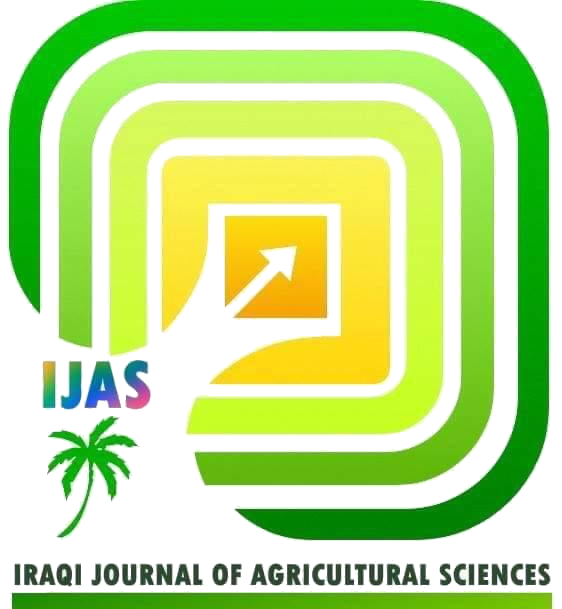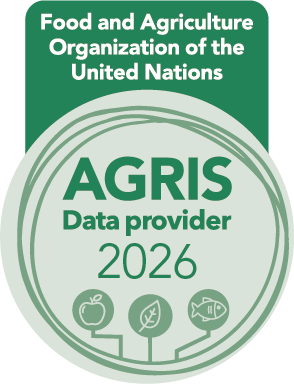FORMATION OF POTENTIAL HETEROTIC GROUPS OF MAIZE INBRED LINES USING VARIATION AT SIMPLE SEQUENCE REPEAT LOCI
DOI:
https://doi.org/10.36103/tnhhjw11Keywords:
Zea mays L., genetic diversity, polymorphism, AMOVAAbstract
This study was aimed to identification of certain crosses to produce hybrids with higher performance per se can be aided by the determination of simple sequence repeats (SSR), which can improve our understanding of the genetic divergence of maize lines and their classification into different heterotic groups. Variability for each locus was measured using the polymorphism information content (PIC), with an average of 0.55, suggesting that the markers were highly informative. Analysis of the molecular variance (AMOVA) indicated higher divergence among the maize lines, suggesting the existence of different groups. The unweighted pair group method with arithmetic mean analysis (UPGMA) and the three-dimensional principal coordinate analysis (PCoA) revealed seven heterotic groups. Therefore, knowledge on the genetic diversity distribution in these maize inbred lines is essential to determine strategies to exploit heterosis in breeding programs in future studies.
References
1. Abdulazeez, S.D., S.A. Kakarash and N.B. Ismael. 2021. Genetic diversity among ten maize genotypes using simple sequence repeat DNA markers. Polytechnic J. 11(1): 32-37. DOI: https://doi.org/10.25156/ptj.v11n1y 2021.pp32-37.
2. Abu Sin, M., G. Saleh, N.A.P. Abdullah and P. Kashiani. 2020. Genetic diversity among tropical maize inbred lines as revealed by SSR markers. Aust. J. Crop Sci. 14(12):2010-2019. DOI: 10.21475/ajcs.20.14.12.1589.
3. Adetimirin, V.O., I. Vroh-Bi, C. The, A. Menkir, S.E. Mitchell and S. Kresovich. 2008. Diversity analysis of elite maize inbred lines adapted to West and Central Africa using SSR markers. Maydica 53: 143-149.
4. Alkazaali, H. A. and F. Y. Baktash. 2017. Impact of corn grain moisture at harvesting to agronomic traits in subsequent generation. Iraqi Journal of Agricultural Sciences, 48(Special). https://doi.org/10.36103/ijas.v48iSpecial.240
5. Alkazaali, H. A. and F. Y. Baktash. 2017. responce of corn grain traits to harvesting moisture. Iraqi Journal of Agricultural Sciences, 48(Special): 18-23. https://doi.org/10.36103/ijas.v48iSpecial.239
6. Brumlop, S., and M.R. Finckh. 2011. Applications and Potentials of Marker-Assisted Selection (MAS) In Plant Breeding. Final report of the F+E Project, Germany. pp: 178.
http://www.bfn.de/0502_ skripten.html
7. Chesnokov, Y.V. and A.M. Artemyeva. 2015. Evaluation of the measure of polymorphism information of genetic diversity. Agric. Biol. 50(5): 571-578.
doi: 10.15389/agrobiology.2015.5.571rus.
8. Desai, S.P., H.C. Lohithaswa, R.L. Ravikumar and R.A. Mohan. 2022. SSR marker assay - based selection of parents for the development of multiparent segregating population in maize (Zea mays L.). Mysore J. Agric. Sci. 56(1): 327-334.
9. Dice, L.R. 1945. Measures of the amount of ecologic association between species. Ecol. 26(3):297-302.
Doi: https://doi.org/10.2307/ 1932409.
10. Elsahookie, M.M., H. A. Alkazaali, and F. Y. Baktash. 2016. Flowering syndrome – hybrid performance relationship in maize 2- yield and yield components. Iraqi Journal of Agricultural Sciences, 47(4): 910-920. https://doi.org/10.36103/ijas.v47i4.519
11. Eidens, H D. M., R N. Bell, S. L. Neuhausen, and T Helentjaris. 1990. DNA sequence variation within maize and melon: observations from polymerase chain reaction amplification and direct sequencing. Genetics, 126(1), 207-217.
12. Excoffier, L. and H.E.L. Lischer. 2010. Arlequin suite ver 3.5: A new series of programs to perform population genetics analyses under Linux and windows. Mol. Ecol. Resour. 10(3): 564-567.
DOI: 10.1111/j.1755-0998.2010.02847.x
13. Ferreira, F., A.S. Carlos, M. Carlos and M. Freddy. 2018. SSR-based genetic analysis of sweet corn inbred lines using artificial neural networks. Crop Breed. Appl. Biotechnol.
18(3): 309-313.DOI: https://doi.org/10.1590/ 1984- 70332018v18n3n45.
14. Kalia, R.K., M.K. Rai, S. Kalia, R. Singh and A.K. Dhawan. 2011. Microsatellite markers: an overview of the recent progress in plants. Euphytica 177:
DOI: 309-334. https://doi.org/10.1007/s10681-010-0286-9
15. Kashiani, P., G. Saleh, J. Panandam, N.A.P. Abdullah and A. Selamat. 2012. Molecular characterization of tropical sweet corn inbred lines using microsatellite markers. Maydica 57(2): 154-163.
16. Ko, W.R., K.J. Sa, N.S. Roy, H.J. Choi and J.K. Lee. 2016. Analysis of the genetic diversity of super sweet corn inbred lines using SSR and SSAP markers. Genet. Mol. Res. 15(1): 1-13. doi: 10.4238/gmr.15017392.
17. Levene, H. 1949. On a matching problem arising in genetics. Ann. Math. Statist. 20(1):91-94. DOI: 10.1214/aoms/1177730093
18. Lewontin, R.C. 1972. Testing the theory of natural selection. Nature 236: 181-182. https://www.jstor.org/stable/e26001389
19. Liu, K. and S. V. Muse. 2005. PowerMarker: Integrated analysis environment for Genetic Marker Data. Bioinformatics 21(9): 2128-2129.
doi: 10.1093/bioinformatics/bti282.
20. MaizeGDB - Maize genome database. 2011. Available at: http://www.maizegdb.org.php. Accessed on July 28, 2011.
21. Mantel, N. 1967. The detection of disease clustering and a generalized regression approach. Cancer Res. 27(2): 209-220.
22. Mustafa, N.R. 2021. Diversity, Performance and Selection of Tropical Sweet Corn Inbred Lines, and Their Combining Abilities In Hybrid Combinations. Ph.D. Thesis, Dep. Of Crop Sci., Fac. Of Agric., Univ. of Putra Malaysia. pp: 190.
23. Neelothpala, M., K.J. Rani, S. Vanisri, P. Sujatha and D. Bhadru. 2022. Genetic diversity assessment of inbred lines in maize through SSR markers. Pharm Innov. J. 11(6): 765-770.
24. Nei, M. 1973. Analysis of gene diversity in subdivided populations. Proc. Natl. Acad. Sci. 70(12): 3321-3323.
DOI: 10.1073/pnas.70.12.3321
25. Oliveira, L.S., S. Ivan, N. Evandro and A.P. Welison. 2021. SNP genotyping for fast and consistent clustering of maize inbred lines into heterotic groups. Crop Breed. Appl. Biotechnol. 21(1): 1-9.
DOI:
https://doi.org/10.1590/1984-70332021v21n1 a10.
26. Oppong, A., C.A. Bedoya, M.B. Ewool, M.D. Asante, R.N. Thomson, H. Adu-Dapaah, J.N.L. Lamtey, K. Ofori, S.K. Offei and M.L. Warburton. 2014. Bulk genetic characterization of Ghanaian maize landraces using microsatellite markers. Maydica 59(1): 1-8.
27. Rohlf, F. 2002. NTSYS-pc: Numerical Taxonomy and Multivariate Analysis System Version 2.1. Exeter Publishing Setauket, New York, USA. pp: 38.
28. Salami, H.A., K.C. Sika, W. Padonou, D. Aly, C. Yallou, A. Adjanohoun, S. Kotchoni and L. Baba-Moussa. 2016. Genetic diversity of maize accessions (Zea mays L.) cultivated from Benin using microsatellites markers. Am. J. Mol. Biol. 6(1): 12-24.
doi: 10.4236/ajmb.2016.61002.
29. Sehgal, D. and S.N. Raina. 2008. DNA Markers and Germplasm Resource Diagnostics: New Perspectives In Crop Improvement and Conservation Strategies. In: Arya, I.D., Arya S. (eds): Utilization of Biotechnology In Plant Sciences. Dehradun: Microsoft Printech (I) Pvt. Ltd. pp: 39–54.
30. Semagn, K., C. Magorokosho, B.S. Vivek, D. Makumbi, Y. Beyene, S. Mugo, B. Prasanna and M. L. Warburton. 2012. Molecular characterization of diverse CIMMYT maize inbred lines from eastern and southern Africa using single nucleotide polymorphic markers. BMC Genom. 13: 113-124. DOI: https://doi.org/10.1186/1471-2164-13-113.
31. Struss, D. and J. Plieske. 1998. The use of microsatellite markers for detection of genetic diversity in barley populations. Theor. Appl. Genet. 97: 308-315.
DOI: https://doi.org/10.1 007/s001220050900.
32. Varshney, R.K., M. Thudi, R. Aggarwal and A. Börner. 2007. Genic Molecular Markers In Plants: Development and Applications. In: Varshney, R.K., Tuberosa R. (eds): Genomics Assisted Crop Improvement: Genomics Approaches and Platforms. Dordrecht: Vol. 1, Springer. pp:13-29.
33. Wegary, D., S.V. Bindiganavile and T.L. Maryke. 2018. Genetic relationships and heterotic structure of quality protein maize (Zea mays L.) inbred lines adapted to eastern and southern Africa. Euphytica 214:1-11. DOI:
https://doi.org/10.1007/s10681-018-2255-7.
34. Weising, K., H. Nybom, M. Pfenninger, K. Wolff and G. Kahl. 2005. DNA Fingerprinting In Plants: Principles, Methods, and Applications. CRC press, Boca Raton. pp: 468. DOI: https://doi.org/10.1201/9781420040043.
35. Xia, X.C., J.C. Reif, A.E. Melchinger, M. Frisch, D.A. Hoisington, D. Beck, K. Picley and M.L. Warburton. 2005. Genetic diversity among CIMMYT maize inbred lines investigated with SSR markers: II. Subtropical, Tropical Midaltitude, and Highland maize inbred lines and their relationships with elite U.S. and European maize. Crop Sci. 45(6): 2573-2582.
DOI: https://doi.org/10.2135/cropsci2005.0246
36. Yeh, F.C., R. Yang and T. Boyle. 1999. POPGENE: Microsoft Windows-Based Freeware for Population Genetic Analysis. Release 1.31. University of Alberta, Canada. pp: 28.
Downloads
Published
Issue
Section
License
Copyright (c) 2025 IRAQI JOURNAL OF AGRICULTURAL SCIENCES

This work is licensed under a Creative Commons Attribution-NonCommercial-NoDerivatives 4.0 International License.

2.jpg)


